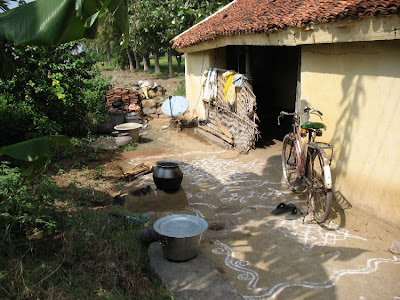For many years families of Brahminy Kites have taken to nesting in the tops of coconut trees on the edge of Samudram Erie near Anaipirandhan Village. Even though Arunachala is regarded as a Shiva Sthalam, the area of Samudram has a long history with the worship of Vishnu. So its particularly appropriate that these beautiful birds have chosen to situate themselves in this area.
In Hindu mythology the various Gods are each associated with a particular 'vahana' which symbolises qualities and powers manifested by that God. In this respect the Garuda (which in India is supposed to be represented by the Brahminy Kite) is the vehicle associated with Lord Vishnu.
The villagers of Anaipirandhan zealously protect their nesting Garudas and often during the evenings you can see groups of folk looking up to take 'darshan' of their favoured birds.
Around this time every year a beautiful puja and feast is arranged in celebration of Lord Vishnu and his mount, the Garuda. But this year through the sterling efforts of a local villager, Venkatesha, sufficient money was gathered to build a small Garuda shrine close to the coconut trees so favoured by the birds.





150 kgs of rice was cooked to feed the large groups of pilgrims visiting the function and opening of the new Garuda Shrine. A very tasty lunch was served under a shamian with Arunachala in the background.

The local cows had a wonderful feast snacking on tasty banana leaves and lots of left overs.

And below one of the nesting Anaipirandhan Brahminy Kites looking down serenely at the gathered crowds of devotees.

A truly wonderful day had by all.











































